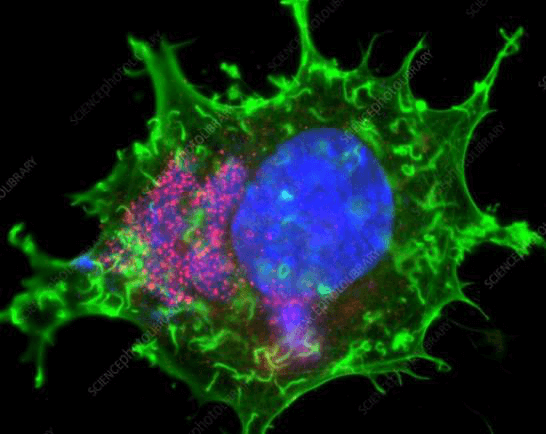Immunofluorescence staining (IF) - strategies used in diagnosis of animal infectious disease for animal health/h1>
The immunofluorescence staining is to detect viral antigen using virus-specific monoclonal or polyclonal antibodies fluorescent staining of viral antigens is visualized under a fluorescent microscope.

Figure 3. Immunofluorescence staining of vaccinia virus infected cell [16]. Areas of virus assembly within the cell are pink. Host and viral DNA (deoxyribonucleic acid) is blue. The host cell's DNA is contained within its nucleus (large oval). Actin protein filaments, which make up part of the cytoskeleton, are green.
Category
Genemedi provides diagnostic antibodies and antigens for the in vitro diagnosis of
diseases from the Companion Animal, Cat/Feline, Dog/Canine, Rabbit, Bovines/Cattle,
Ovines/Sheep, Caprine/Goat, Equine/Horse, Swine/Porcine/Pig, Avian/bird/poultry, Fish and so
on.
Animal category
Disease category
Veterinary NCDs (noncommunicable diseases)
-
· Acute inflammation, infections
· Inflammatory diseases, infections
· Myocardial injury, heart disease· Bacterial infections, sepsis
· Heart failure, cardiac disease
· Thrombosis, disseminated intravascular coagulation
Veterinary Infectious Disease
-
· Infectious bursal/Gumboro disease
· Foot and mouth disease
· Hemolytic uremic syndrome/E. coli infection· Bovine spongiform encephalopathy (BSE)
· Brucella abortus, Brucella melitensis, Brucellosis
· Monkeypox, cowpox
Technical resource
Reference:
1. Ryu, S., et al., One Health Perspectives on Emerging Public Health Threats. J Prev Med Public Health, 2017. 50(6): p. 411-414.
2. World Health Organization (WHO). Zoonoses. Accessed October 3, 2018.; Available from: http://www.who.int/zoonoses.
3. Leslie MJ, M.J. Surveillance for zoonotic diseases. BLUKO97- Mikanatha 2007; Available from: http://courses.washington.edu/zepi526/Papers08/Rabies%20chapter.pdf.
4. Available from: https://www.doctorsgate.com/en/what-are-the-current-diagnostic-tests-for-covid-19/.
5. Anylab. Available from: www.zetbio.com.
6. Li, H., et al., A new and rapid approach for detecting COVID-19 based on S1 protein fragments. Clin Transl Med, 2020. 10(2): p. e90.
7. Khanna, M., et al., Evaluation of influenza virus detection by direct enzyme immunoassay (EIA) and conventional methods in asthmatic patients. J Commun Dis, 2001. 33(3): p. 163-9.
8. Waner, J.L., et al., Comparison of Directigen FLU-A with viral isolation and direct immunofluorescence for the rapid detection and identification of influenza A virus. J Clin Microbiol, 1991. 29(3): p. 479-82.
9. Cameron, J.D., A.P. Skubitz, and L.T. Furcht, Type IV collagen and corneal epithelial adhesion and migration. Effects of type IV collagen fragments and synthetic peptides on rabbit corneal epithelial cell adhesion and migration in vitro. Invest Ophthalmol Vis Sci, 1991. 32(10): p. 2766-73.
10. Kim, M.H., S.Y. Kang, and W.I. Lee, Evaluation of a new rapid test kit to detect hepatitis C virus infection. J Virol Methods, 2013. 193(2): p. 379-82.
11. Niu, X., et al., [Establishment of the evaluation reference system for domestic anti-hepatitis C virus diagnostic enzyme immunoassay kits]. Xi Bao Yu Fen Zi Mian Yi Xue Za Zhi, 2013. 29(7): p. 761-4.
12. Filice, G., et al., Sensitivity and specificity of anti-HIV ELISA employing recombinant (p24, p66, gp120) and synthetic (gp41) viral antigenic peptides. Microbiologica, 1991. 14(3): p. 185-94.
13. de Boer, G.F., W. Back, and A.D. Osterhaus, An ELISA for detection of antibodies against influenza A nucleoprotein in humans and various animal species. Arch Virol, 1990. 115(1-2): p. 47-61.
14. Cuzzubbo, A.J., et al., Comparison of PanBio dengue duo enzyme-linked immunosorbent assay (ELISA) and MRL dengue fever virus immunoglobulin M capture ELISA for diagnosis of dengue virus infections in Southeast Asia. Clin Diagn Lab Immunol, 1999. 6(5): p. 705-12.
15. Maria-C-Jimenez-Martinez. Available from:
https://www.researchgate.net/profile/Maria-C-Jimenez-Martinez/publication/320265684/figure/fig3/AS:547016444395520@1507430291554/ELISA-assays-Direct-ELISA-mostly-used-for-antigen-detection-Indirect-ELISA-mainly-used.png.
16. sciencephoto. Available from: https://www.sciencephoto.com/media/90184/view.
17. Uyeki, T.M., et al., Clinical Practice Guidelines by the Infectious Diseases Society of America: 2018 Update on Diagnosis, Treatment, Chemoprophylaxis, and Institutional Outbreak Management of Seasonal Influenzaa. Clin Infect Dis, 2019. 68(6): p. e1-e47.
18. Goldsmith, C. Hantavirus Life Cycle and Infection Process. Available from: https://www.hantasite.com/2017/03/hantavirus-life-cycle-and-infection.html.
19. METHODS, M. 2013; 3:207
20. biotech, G.; Available from: https://www.globalbiotechinsights.com/articles/20247/the-worldwide-test-for-covid-19.






